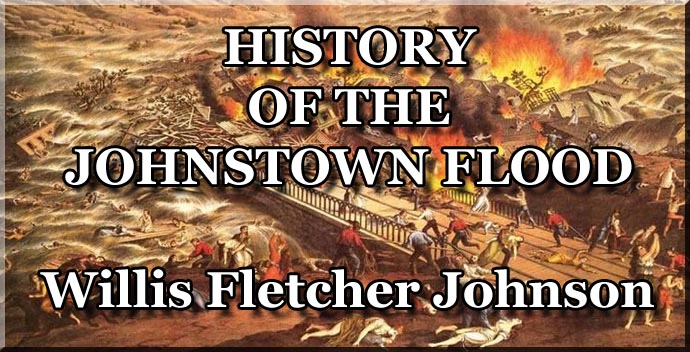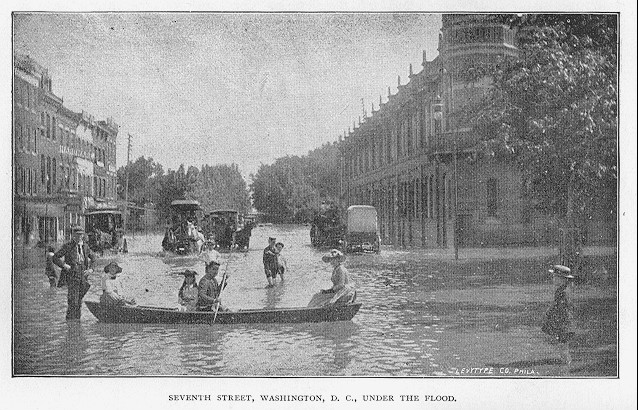
History of the Johnstown Flood
By Willis Fletcher Johnson
Chapter 33
|
A mantle of mist hung low over the Conemaugh Valley when the people of Johnstown rose on Sunday morning, June 9th; but about the time the two remaining church bells began to toll, the sun's rays broke through the fog, and soon the sky was clear save for a few white clouds which sailed lazily to the Alleghenies. Never in the history of Johnstown did congregations attend more impressive church services. Some of them were held in the open air, others in half-ruined buildings, and one only in a church. The ceremonies were deeply solemon and touching. Early in the forenoon German Catholics picked their way through the wreck to the parsonage of St. Joseph's, where Fathers Kesbernan and Aid said four masses. Next to the parsonage there was a great breach in the walls made by the flood, and one-half of the parsonage had been carried away. At one end of the pastor's reception-room had been placed a temporary alter lighted by a solitary candle. There were white roses upon it, while from the walls, above the muddy stains, hung pictures of the Immaculate Conception, the Crucifixion, and the Virgin Mary. The room was filled with worshipers, and the people spread out into the lateral hall hanging over the cellar washed bare of its covering. No chairs or benches were in the room. There was a deep hush as the congregation knelt upon the damp floors, silently saying their prayers. With a dignified and serene demeanors, the priest went through the services of his church, while the people before him were motionless, the men with bowed heads, the women holding handkerchiefs to their faces.
Back of this church, on the side of a hill, there gathered another congregation of Catholics. Their church and parsonage and chapel had all been destroyed, and they met in a yard near their cemetery. A pretty arbor, covered with vines, ran back from the street, and beneath this stood their priest, Father Tahney, who had worked with them over a quarter of a century. His hair was white, but he stood erect as he talked to his people. Before him was a white alter. This, too, was lighted with a single candle. The people stood before him and on each side, reverently kneeling on the grass as they prayed. Three masses were said by Father Tahney and by Father Matthews, of Washington, and then the white-haired priest spoke a few words of encouragement to his listeners. He urged them to make a manful struggle to rebuild their homes, to assist one another in their distress, and to be grateful to all Americans for the helping hand extended to them. Other Catholic services were held at the St. Columba's Church, in Cambria, where Father Troutwein, of St. Mary's Church, Fathers Davin and Smith said mass and addressed the congregation. Father Smith urged them not to sell their lands to those who were speculating in the men's misery, but to be courageous until the city should rise again. At the Pennsylvania station a meeting was held on the embankment overlook the ruined part of the town. The services were conducted by the Rev. Mr. McGuire, chaplain of the 14th Regiment. The people sang “Come, Thou Fount of Every Blessing,” and then Mr. McGuire read the psalm beginning “I will bless the lord at all times.” James Fulton, manager of the Cambria Iron Works, spoke encouraging words. He assured them that the works would be rebuilt, and that the eight thousand employees would be cared for. Houses would be built for them and employment given to all in restoring the works. L There was a strained look on men's faces when he told them in a low voice that he held the copy of a report which he had drawn up on the dam, calling attention to the fact that it was extremely dangerous to the people living in the valley. One of the peculiar things a stranger notices in Johnstown is the comparatively small number of women seen in the place. Of the throngs who walk about the streets searching for dead friends, there is not one woman to ten men. Occasionally a little group of two or three women with sad faces will pick there way about, looking for the morgues. There are a few Sisters of Charity, in their black robes, seen upon the streets, and in the parts of the town not totally destroyed and the usual number of women are seen in the houses and yards. But, as a rule, women are a rarity in Johnstown now. This is not a natural peculiarity of Johnstown, nor a mere coincidence, but a fact with a dreadful reason behind it. There are so many more men than women among the living in Johnstown now, because there are so many more women than men than men among the dead. Of the bodies recovered there are at least two women for every man. Besides the fact that their natural weakness made them an easier prey to the flood, the hour at which the disaster came was one when the women would most likely be in their homes and the men at work in the open air or in factory yards, from which escape was easy. Children also are rarely seen about the town, and for a similar reason. They are all dead. There is never a group of the dead discovered that does not contain from one to three or four children for every grown person. Generally the children are in the arms of the grown persons, and often little toys and trinkets clasped in their hands indicate that the children were caught up while at play, and carried as far as possible toward safety. Johnstown when rebuilt will be a city of many widowers and few children. In turning a school house into a morgue the authorities probably did a wiser thing than they thought. It will be a long time before the school house will be needed for its original purpose. The miracle, as it is called, that happened at the Church of the Immaculate Conception, has caused a tremendous sensation. A large number of persons will testify as to the nature of the event, and, to put it mildly, the circumstances are really remarkable. The devotions in honor of the Blessed Virgin celebrated daily during the month of May were in progress on that Friday when the water descended on Cambria City. The church was filled with people at the time, but when the noise of the flood was heard the congregation hastened to get out of the way. They succeeded as far as escaping from the interior is concerned, and in a few minutes the church was partially submerged, the water reaching fifteen feet up the sides and swirling around the corners furiously. The building was badly wrecked, the benches were torn out, and in general the entire structure, both inside and outside, was fairly dismantled. Yesterday morning, when an entrance was forced through the blocked doorway the ruin appeared to be complete. One object alone had escaped the water's wrath. The statue of the Blessed Virgin, that had been decorated and adorned because of the May devotions, was as unsullied as the day it was made. The flowers, the wreaths, the lace veil were undisturbed and unsoiled, although the marks on the wall showed that the surface of the water had risen above the statue to a height of fifteen feet, while the statue nevertheless had been saved from all contact with the liquid. Every one who has seen the statue and its surroundings is firmly convinced that the incident was a miraculous one and even the most skeptical the affair savors of the supernatural. A singular feature of the great flood was discovered at the great stone viaduct about half way between Mineral Point and South Fork. At Mineral Point the Pennsylvania Railroad is on the south side of the river, although the town is on the north side. About a mile and a half up the stream there was a viaduct built of very solid masonry. It was originally built for the old Portage Road. It was seventy-eight feet above the ordinary surface of the water. On this viaduct the railroad tracks crossed to the north side of the river and on that side ran into South Fork, two miles farther up. It is the general opinion of engineers that this strong viaduct would have stood against the gigantic wave had it not been blown up by dynamite. But at South Fork there was a dynamite magazine which was picked up by the flood and shot down the stream at the rate of twenty miles an hour. It struck the stone viaduct and exploded. The roar of the flood was tremendous, but the noise of this explosion was heard by farmers on the Evanston Road, two miles and a half away. Persons living on the mountain sides, in view of the river, and who saw the explosion, say that the stones of the viaduct at the point where the magazine struck it, were thrown into the air to a height of two hundred feet. An opening was made, and the flood of death swept through on its awful errand.
|
|
 |
 |
|
|
|
-
Site Navigation
 Home
Home What's New
What's New Bible
Bible Photos
Photos Hiking
Hiking E-Books
E-Books Genealogy
Genealogy Profile
Free Plug-ins You May Need
Profile
Free Plug-ins You May Need
 Get Java
Get Java.png) Get Flash
Get Flash Get 7-Zip
Get 7-Zip Get Acrobat Reader
Get Acrobat Reader Get TheWORD
Get TheWORD
